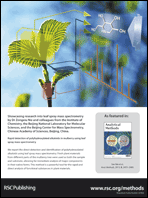The latest issue of Analytical Methods is now available online. We have three beautiful covers featuring the most recent advances in the field of applied analytical chemistry.
Our outside front cover showcases the work of Xing-Jiu Huang and colleagues at the Chinese Academy of Sciences. The researchers introduce a new method to identify and quantify chlorobenzene micropollutants that are present in the natural environment. These pollutants have poor electrochemical activity and have been difficult to identify with electrochemical sensors. In this work, a novel ionic liquid–carbon nanotube composite sensor based on electrochemical impendance technique is proposed as an efficient sensor for micropollutants with poor electrochemical activity.
Ionic liquid–carbon nanotube composites as scaffolds in the determination of tetrachlorobenzene: electrochemical impedance technique
Yan Wei, Zhong-Gang Liu, Xing Chen, Jin-Huai Liu and Xing-Jiu Huang
Anal. Methods, 2013, 5, 2440-2443
DOI: 10.1039/C3AY00022B
The wonderful inside front cover of this issue features the paper of Susan Wolf and William Reagen from the Environmental Laboratory 3M Centre, St. Paul, USA. In the study, the authors report a novel analytical method for analysis of perfluorinated compounds in water. In particular, they optimise and validate a technique based on pre-sampling isotope dilution-direct injection-liquid chromatography tandem mass spectrometry (DI-LC/MS/MS).
Method and validation for the analysis of perfluorinated compounds in water by pre-sampling isotope dilution-direct injection-LC/MS/MS
Susan T. Wolf and William K. Reagen
Anal. Methods, 2013, 5, 2444-2454
DOI: 10.1039/C3AY26347A
Finally, the outside back cover of Issue 10 shows the research study of Zongxiu Nie and co-workers at the Chinese Academy of Sciences. In their work, the researchers present the rapid and direct detection of polyhydroxylated alkaloids in mulberry using leaf spray mass spectrometry and propose the leaf spray method for the rapid screening of lead compounds from natural plants during drug development.
Rapid detection of polyhydroxylated alkaloids in mulberry using leaf spray mass spectrometry
Ning Zhang, Yafeng Li, Yueming Zhou, Jian Hou, Qing He, Xiang-Guo Hu, Yue-Mei Jia, Chu-Yi Yu and Zongxiu Nie
Anal. Methods, 2013, 5, 2455-2460
DOI: 10.1039/C3AY00018D













